Nike Company: Financial Performance, Ratios, and Strategy Analysis
VerifiedAdded on 2020/12/08
|8
|3035
|189
Report
AI Summary
This report offers a detailed examination of the Nike company, encompassing its historical background, product offerings, organizational structure, and recent strategic initiatives. The analysis delves into Nike's financial performance, evaluating key ratios such as sales growth, gross profit margin, operating margin, return on equity (ROE), return on assets (ROA), and return on investment (ROI) across the years 2015, 2016, and 2017. It assesses the company's solvency through debt-to-equity and time interest earned ratios, as well as liquidity using current and quick ratios. Furthermore, the report analyzes the cash conversion cycle and utilizes DuPont analysis to identify the main drivers of changes in ROE, assessing the consistency of these changes with Nike's overall business strategy. The report also compares Nike's performance to industry averages, providing insights into its competitive positioning and future prospects. The analysis covers income statement, balance sheet, and return ratios, offering a holistic view of Nike's financial health and operational efficiency.
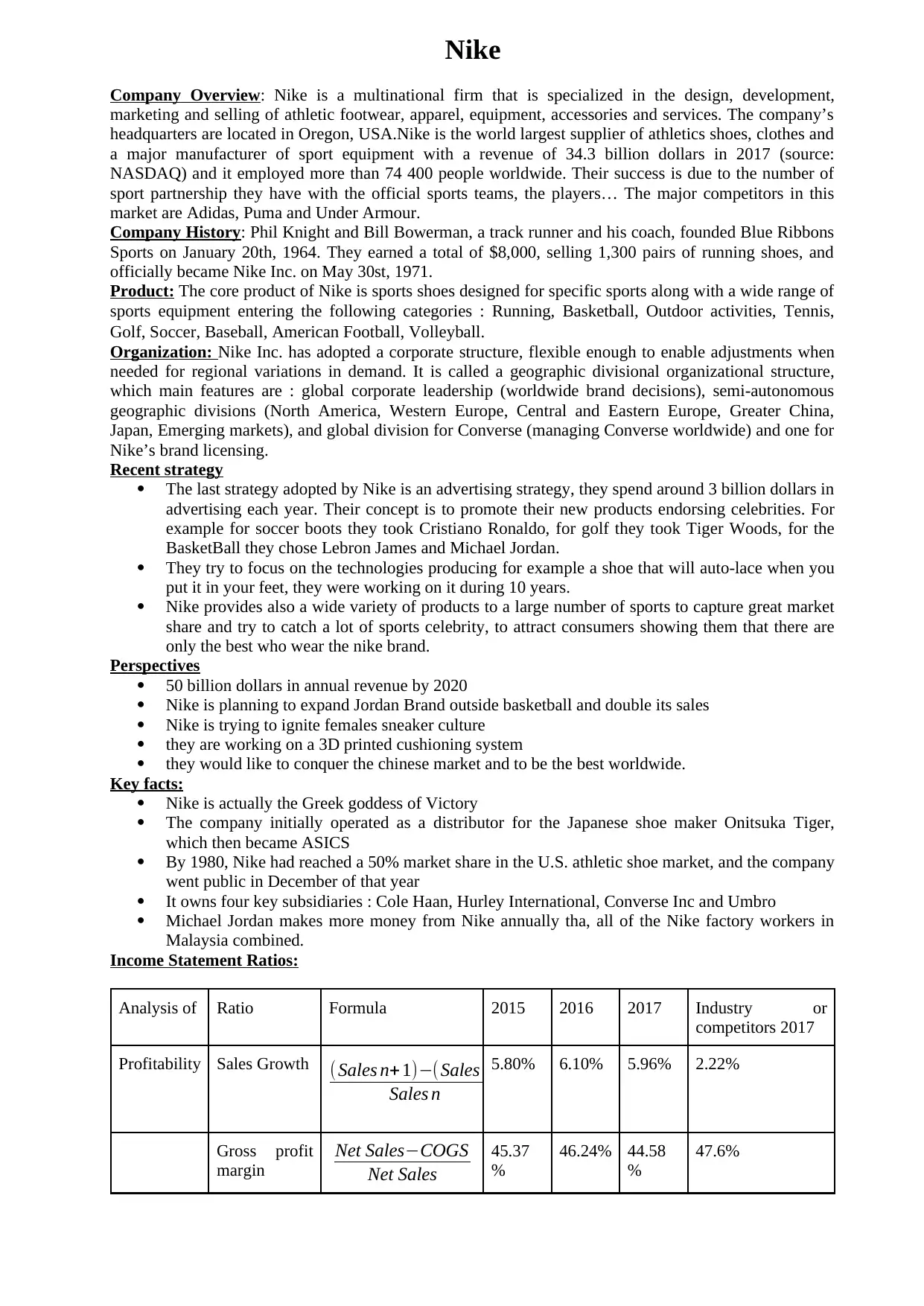
Nike
Company Overview: Nike is a multinational firm that is specialized in the design, development,
marketing and selling of athletic footwear, apparel, equipment, accessories and services. The company’s
headquarters are located in Oregon, USA.Nike is the world largest supplier of athletics shoes, clothes and
a major manufacturer of sport equipment with a revenue of 34.3 billion dollars in 2017 (source:
NASDAQ) and it employed more than 74 400 people worldwide. Their success is due to the number of
sport partnership they have with the official sports teams, the players… The major competitors in this
market are Adidas, Puma and Under Armour.
Company History: Phil Knight and Bill Bowerman, a track runner and his coach, founded Blue Ribbons
Sports on January 20th, 1964. They earned a total of $8,000, selling 1,300 pairs of running shoes, and
officially became Nike Inc. on May 30st, 1971.
Product: The core product of Nike is sports shoes designed for specific sports along with a wide range of
sports equipment entering the following categories : Running, Basketball, Outdoor activities, Tennis,
Golf, Soccer, Baseball, American Football, Volleyball.
Organization: Nike Inc. has adopted a corporate structure, flexible enough to enable adjustments when
needed for regional variations in demand. It is called a geographic divisional organizational structure,
which main features are : global corporate leadership (worldwide brand decisions), semi-autonomous
geographic divisions (North America, Western Europe, Central and Eastern Europe, Greater China,
Japan, Emerging markets), and global division for Converse (managing Converse worldwide) and one for
Nike’s brand licensing.
Recent strategy
The last strategy adopted by Nike is an advertising strategy, they spend around 3 billion dollars in
advertising each year. Their concept is to promote their new products endorsing celebrities. For
example for soccer boots they took Cristiano Ronaldo, for golf they took Tiger Woods, for the
BasketBall they chose Lebron James and Michael Jordan.
They try to focus on the technologies producing for example a shoe that will auto-lace when you
put it in your feet, they were working on it during 10 years.
Nike provides also a wide variety of products to a large number of sports to capture great market
share and try to catch a lot of sports celebrity, to attract consumers showing them that there are
only the best who wear the nike brand.
Perspectives
50 billion dollars in annual revenue by 2020
Nike is planning to expand Jordan Brand outside basketball and double its sales
Nike is trying to ignite females sneaker culture
they are working on a 3D printed cushioning system
they would like to conquer the chinese market and to be the best worldwide.
Key facts:
Nike is actually the Greek goddess of Victory
The company initially operated as a distributor for the Japanese shoe maker Onitsuka Tiger,
which then became ASICS
By 1980, Nike had reached a 50% market share in the U.S. athletic shoe market, and the company
went public in December of that year
It owns four key subsidiaries : Cole Haan, Hurley International, Converse Inc and Umbro
Michael Jordan makes more money from Nike annually tha, all of the Nike factory workers in
Malaysia combined.
Income Statement Ratios:
Analysis of Ratio Formula 2015 2016 2017 Industry or
competitors 2017
Profitability Sales Growth ( Sales n+ 1)−(Sales n)
Sales n
5.80% 6.10% 5.96% 2.22%
Gross profit
margin
Net Sales−COGS
Net Sales
45.37
%
46.24% 44.58
%
47.6%
Company Overview: Nike is a multinational firm that is specialized in the design, development,
marketing and selling of athletic footwear, apparel, equipment, accessories and services. The company’s
headquarters are located in Oregon, USA.Nike is the world largest supplier of athletics shoes, clothes and
a major manufacturer of sport equipment with a revenue of 34.3 billion dollars in 2017 (source:
NASDAQ) and it employed more than 74 400 people worldwide. Their success is due to the number of
sport partnership they have with the official sports teams, the players… The major competitors in this
market are Adidas, Puma and Under Armour.
Company History: Phil Knight and Bill Bowerman, a track runner and his coach, founded Blue Ribbons
Sports on January 20th, 1964. They earned a total of $8,000, selling 1,300 pairs of running shoes, and
officially became Nike Inc. on May 30st, 1971.
Product: The core product of Nike is sports shoes designed for specific sports along with a wide range of
sports equipment entering the following categories : Running, Basketball, Outdoor activities, Tennis,
Golf, Soccer, Baseball, American Football, Volleyball.
Organization: Nike Inc. has adopted a corporate structure, flexible enough to enable adjustments when
needed for regional variations in demand. It is called a geographic divisional organizational structure,
which main features are : global corporate leadership (worldwide brand decisions), semi-autonomous
geographic divisions (North America, Western Europe, Central and Eastern Europe, Greater China,
Japan, Emerging markets), and global division for Converse (managing Converse worldwide) and one for
Nike’s brand licensing.
Recent strategy
The last strategy adopted by Nike is an advertising strategy, they spend around 3 billion dollars in
advertising each year. Their concept is to promote their new products endorsing celebrities. For
example for soccer boots they took Cristiano Ronaldo, for golf they took Tiger Woods, for the
BasketBall they chose Lebron James and Michael Jordan.
They try to focus on the technologies producing for example a shoe that will auto-lace when you
put it in your feet, they were working on it during 10 years.
Nike provides also a wide variety of products to a large number of sports to capture great market
share and try to catch a lot of sports celebrity, to attract consumers showing them that there are
only the best who wear the nike brand.
Perspectives
50 billion dollars in annual revenue by 2020
Nike is planning to expand Jordan Brand outside basketball and double its sales
Nike is trying to ignite females sneaker culture
they are working on a 3D printed cushioning system
they would like to conquer the chinese market and to be the best worldwide.
Key facts:
Nike is actually the Greek goddess of Victory
The company initially operated as a distributor for the Japanese shoe maker Onitsuka Tiger,
which then became ASICS
By 1980, Nike had reached a 50% market share in the U.S. athletic shoe market, and the company
went public in December of that year
It owns four key subsidiaries : Cole Haan, Hurley International, Converse Inc and Umbro
Michael Jordan makes more money from Nike annually tha, all of the Nike factory workers in
Malaysia combined.
Income Statement Ratios:
Analysis of Ratio Formula 2015 2016 2017 Industry or
competitors 2017
Profitability Sales Growth ( Sales n+ 1)−(Sales n)
Sales n
5.80% 6.10% 5.96% 2.22%
Gross profit
margin
Net Sales−COGS
Net Sales
45.37
%
46.24% 44.58
%
47.6%
Paraphrase This Document
Need a fresh take? Get an instant paraphrase of this document with our AI Paraphraser

Operating
margin
EBIT
Net Sales
13.64
%
13.91% 13.83
%
13.08%
Return on
sales
Net income
Net Sales
11.61
%
12.34% 5.3%
First of all, there is an increase in sales from 5.80% in 2015 to 6.10% in 2016 but a decrease in 2017
(5.96%). However, the sales growth stays above the industry and competitors, so Nike is performing well.
The gross profit margin measures the efficiency and it is expressed as a percentage of sales. It Indicates
how much profit a company makes after paying off its Cost of Goods Sold. It has increased from 2015 to
2016 but then decreases from 2016 to 2017. For instance, the company’s gross profit margin in 2017 is a
bit lower than the industry, so a lower gross profit margin could indicate that the company is
underpricing. The higher the gross profit margin the more efficient a company is so here we can see that it
is a bit less efficient than the industry.
Moreover, the operating margin measures the ability to translate sales into profit after consideration of
operating expenses. Here we can see a slight increase from 2015 to 2016 but a decrease in 2017 compared
to 2016. It still remains quite stable over the years. In 2017, it stays above the average of the market so it
more profitable than the average industry.
In relation to the ROS, there is an important decrease from 12,34% in 2016 to 5,3% in 2017, so we could
say that the ability to translate sales into profit (after consideration of all expenses and revenues, including
interest, taxes, and non-operating items) has decrease. We need further examination of the financial health
of the company to understand this decrease.
Balance Sheet Ratios :
Analys
is of
Ratio Formula 2015 2016 2017 Industry or
competitors
2017
Solven
cy
Debt to
equity Total debt (¿<liabilities)
Total shareholders' equity
0.75 0.87 1.30 0.2
TIE EBIT
Interest Payments
240.6
times
84.6
times
82.22
times
Long
term
debt to
operati
ng cash
¿ Debt (LDT )
Operatingcash (¿ Net income+depreciation)
1.21
years
1.52
years
5.6 years
Liquidi
ty
Current
ratio
(in
times)
Current assets
Current liabilities
3.04 3.06 2.46 3.06
Quick
ratio Cash+ ST investments + AR
Current liabilities
2.21 1.90 1.67 0.8
Net
Workin
g
Capital
Current assets – Current liabilities 96670
00
105870
00
9094000
Averag
e
collecti
on
period
AR
Sales∗360 36.04 38.54 34.60
margin
EBIT
Net Sales
13.64
%
13.91% 13.83
%
13.08%
Return on
sales
Net income
Net Sales
11.61
%
12.34% 5.3%
First of all, there is an increase in sales from 5.80% in 2015 to 6.10% in 2016 but a decrease in 2017
(5.96%). However, the sales growth stays above the industry and competitors, so Nike is performing well.
The gross profit margin measures the efficiency and it is expressed as a percentage of sales. It Indicates
how much profit a company makes after paying off its Cost of Goods Sold. It has increased from 2015 to
2016 but then decreases from 2016 to 2017. For instance, the company’s gross profit margin in 2017 is a
bit lower than the industry, so a lower gross profit margin could indicate that the company is
underpricing. The higher the gross profit margin the more efficient a company is so here we can see that it
is a bit less efficient than the industry.
Moreover, the operating margin measures the ability to translate sales into profit after consideration of
operating expenses. Here we can see a slight increase from 2015 to 2016 but a decrease in 2017 compared
to 2016. It still remains quite stable over the years. In 2017, it stays above the average of the market so it
more profitable than the average industry.
In relation to the ROS, there is an important decrease from 12,34% in 2016 to 5,3% in 2017, so we could
say that the ability to translate sales into profit (after consideration of all expenses and revenues, including
interest, taxes, and non-operating items) has decrease. We need further examination of the financial health
of the company to understand this decrease.
Balance Sheet Ratios :
Analys
is of
Ratio Formula 2015 2016 2017 Industry or
competitors
2017
Solven
cy
Debt to
equity Total debt (¿<liabilities)
Total shareholders' equity
0.75 0.87 1.30 0.2
TIE EBIT
Interest Payments
240.6
times
84.6
times
82.22
times
Long
term
debt to
operati
ng cash
¿ Debt (LDT )
Operatingcash (¿ Net income+depreciation)
1.21
years
1.52
years
5.6 years
Liquidi
ty
Current
ratio
(in
times)
Current assets
Current liabilities
3.04 3.06 2.46 3.06
Quick
ratio Cash+ ST investments + AR
Current liabilities
2.21 1.90 1.67 0.8
Net
Workin
g
Capital
Current assets – Current liabilities 96670
00
105870
00
9094000
Averag
e
collecti
on
period
AR
Sales∗360 36.04 38.54 34.60
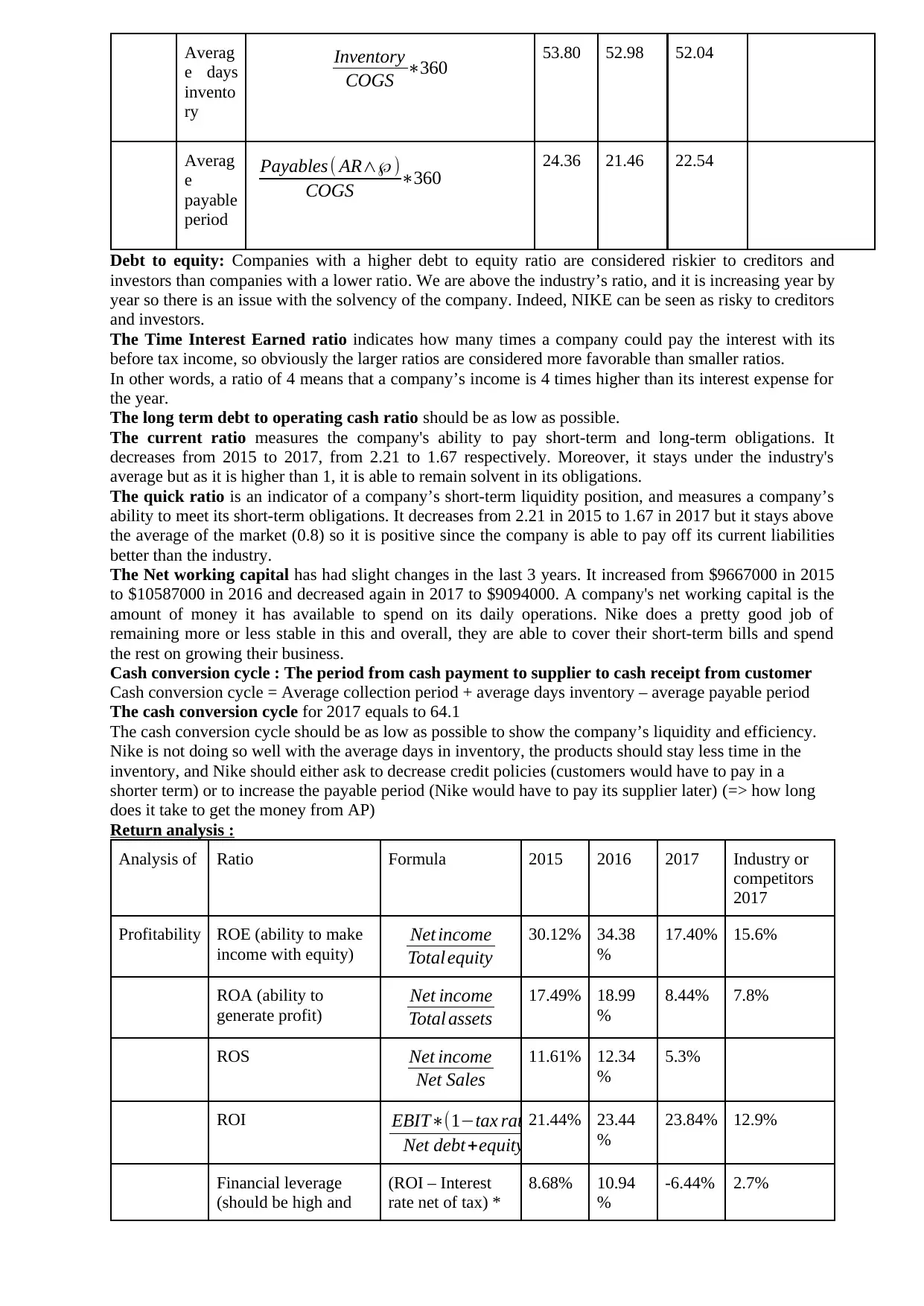
Averag
e days
invento
ry
Inventory
COGS ∗360 53.80 52.98 52.04
Averag
e
payable
period
Payables( AR∧℘)
COGS ∗360 24.36 21.46 22.54
Debt to equity: Companies with a higher debt to equity ratio are considered riskier to creditors and
investors than companies with a lower ratio. We are above the industry’s ratio, and it is increasing year by
year so there is an issue with the solvency of the company. Indeed, NIKE can be seen as risky to creditors
and investors.
The Time Interest Earned ratio indicates how many times a company could pay the interest with its
before tax income, so obviously the larger ratios are considered more favorable than smaller ratios.
In other words, a ratio of 4 means that a company’s income is 4 times higher than its interest expense for
the year.
The long term debt to operating cash ratio should be as low as possible.
The current ratio measures the company's ability to pay short-term and long-term obligations. It
decreases from 2015 to 2017, from 2.21 to 1.67 respectively. Moreover, it stays under the industry's
average but as it is higher than 1, it is able to remain solvent in its obligations.
The quick ratio is an indicator of a company’s short-term liquidity position, and measures a company’s
ability to meet its short-term obligations. It decreases from 2.21 in 2015 to 1.67 in 2017 but it stays above
the average of the market (0.8) so it is positive since the company is able to pay off its current liabilities
better than the industry.
The Net working capital has had slight changes in the last 3 years. It increased from $9667000 in 2015
to $10587000 in 2016 and decreased again in 2017 to $9094000. A company's net working capital is the
amount of money it has available to spend on its daily operations. Nike does a pretty good job of
remaining more or less stable in this and overall, they are able to cover their short-term bills and spend
the rest on growing their business.
Cash conversion cycle : The period from cash payment to supplier to cash receipt from customer
Cash conversion cycle = Average collection period + average days inventory – average payable period
The cash conversion cycle for 2017 equals to 64.1
The cash conversion cycle should be as low as possible to show the company’s liquidity and efficiency.
Nike is not doing so well with the average days in inventory, the products should stay less time in the
inventory, and Nike should either ask to decrease credit policies (customers would have to pay in a
shorter term) or to increase the payable period (Nike would have to pay its supplier later) (=> how long
does it take to get the money from AP)
Return analysis :
Analysis of Ratio Formula 2015 2016 2017 Industry or
competitors
2017
Profitability ROE (ability to make
income with equity)
Net income
Total equity
30.12% 34.38
%
17.40% 15.6%
ROA (ability to
generate profit)
Net income
Total assets
17.49% 18.99
%
8.44% 7.8%
ROS Net income
Net Sales
11.61% 12.34
%
5.3%
ROI EBIT∗(1−tax rate)
Net debt+equity
21.44% 23.44
%
23.84% 12.9%
Financial leverage
(should be high and
(ROI – Interest
rate net of tax) *
8.68% 10.94
%
-6.44% 2.7%
e days
invento
ry
Inventory
COGS ∗360 53.80 52.98 52.04
Averag
e
payable
period
Payables( AR∧℘)
COGS ∗360 24.36 21.46 22.54
Debt to equity: Companies with a higher debt to equity ratio are considered riskier to creditors and
investors than companies with a lower ratio. We are above the industry’s ratio, and it is increasing year by
year so there is an issue with the solvency of the company. Indeed, NIKE can be seen as risky to creditors
and investors.
The Time Interest Earned ratio indicates how many times a company could pay the interest with its
before tax income, so obviously the larger ratios are considered more favorable than smaller ratios.
In other words, a ratio of 4 means that a company’s income is 4 times higher than its interest expense for
the year.
The long term debt to operating cash ratio should be as low as possible.
The current ratio measures the company's ability to pay short-term and long-term obligations. It
decreases from 2015 to 2017, from 2.21 to 1.67 respectively. Moreover, it stays under the industry's
average but as it is higher than 1, it is able to remain solvent in its obligations.
The quick ratio is an indicator of a company’s short-term liquidity position, and measures a company’s
ability to meet its short-term obligations. It decreases from 2.21 in 2015 to 1.67 in 2017 but it stays above
the average of the market (0.8) so it is positive since the company is able to pay off its current liabilities
better than the industry.
The Net working capital has had slight changes in the last 3 years. It increased from $9667000 in 2015
to $10587000 in 2016 and decreased again in 2017 to $9094000. A company's net working capital is the
amount of money it has available to spend on its daily operations. Nike does a pretty good job of
remaining more or less stable in this and overall, they are able to cover their short-term bills and spend
the rest on growing their business.
Cash conversion cycle : The period from cash payment to supplier to cash receipt from customer
Cash conversion cycle = Average collection period + average days inventory – average payable period
The cash conversion cycle for 2017 equals to 64.1
The cash conversion cycle should be as low as possible to show the company’s liquidity and efficiency.
Nike is not doing so well with the average days in inventory, the products should stay less time in the
inventory, and Nike should either ask to decrease credit policies (customers would have to pay in a
shorter term) or to increase the payable period (Nike would have to pay its supplier later) (=> how long
does it take to get the money from AP)
Return analysis :
Analysis of Ratio Formula 2015 2016 2017 Industry or
competitors
2017
Profitability ROE (ability to make
income with equity)
Net income
Total equity
30.12% 34.38
%
17.40% 15.6%
ROA (ability to
generate profit)
Net income
Total assets
17.49% 18.99
%
8.44% 7.8%
ROS Net income
Net Sales
11.61% 12.34
%
5.3%
ROI EBIT∗(1−tax rate)
Net debt+equity
21.44% 23.44
%
23.84% 12.9%
Financial leverage
(should be high and
(ROI – Interest
rate net of tax) *
8.68% 10.94
%
-6.44% 2.7%
⊘ This is a preview!⊘
Do you want full access?
Subscribe today to unlock all pages.

Trusted by 1+ million students worldwide
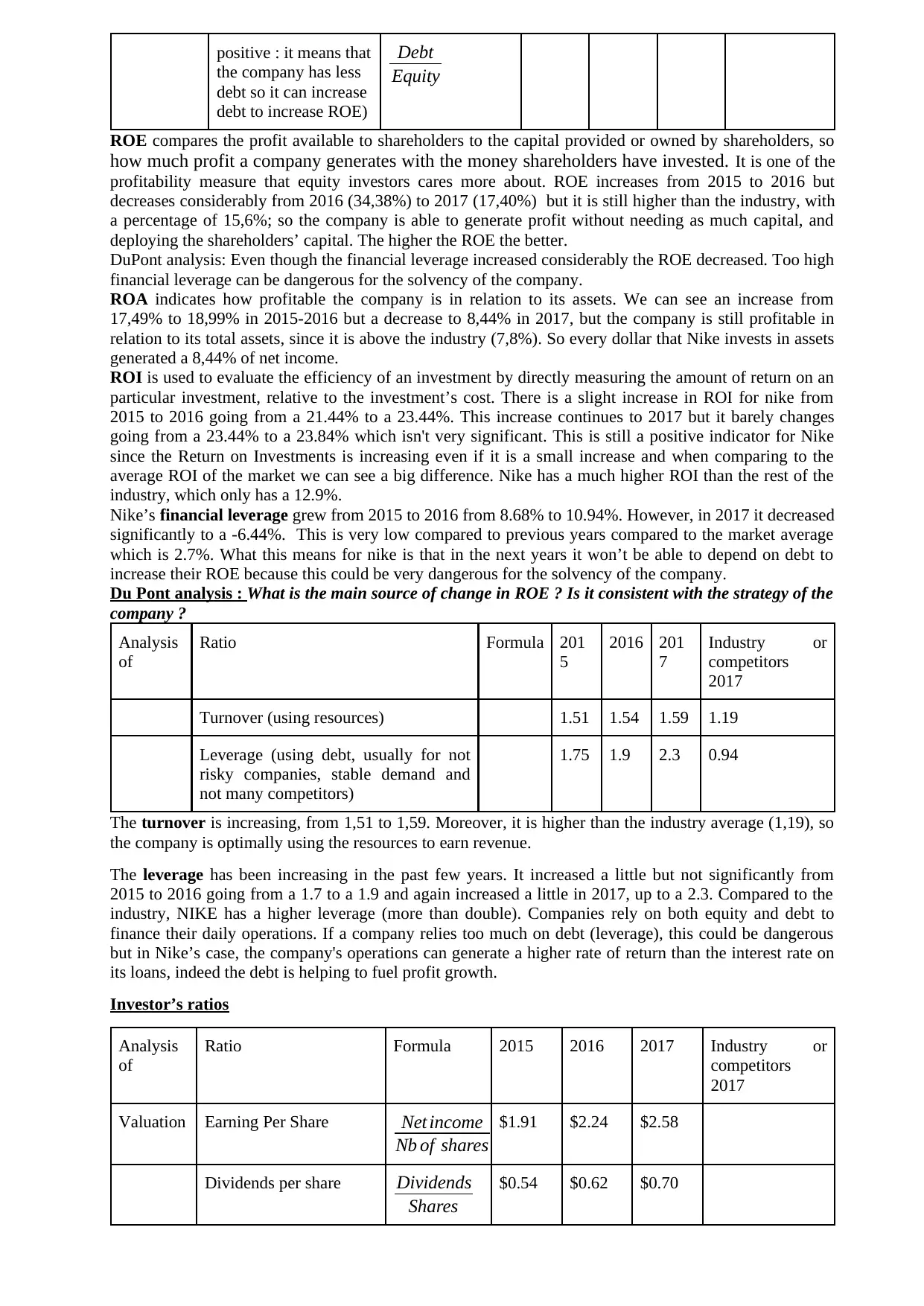
positive : it means that
the company has less
debt so it can increase
debt to increase ROE)
Debt
Equity
ROE compares the profit available to shareholders to the capital provided or owned by shareholders, so
how much profit a company generates with the money shareholders have invested. It is one of the
profitability measure that equity investors cares more about. ROE increases from 2015 to 2016 but
decreases considerably from 2016 (34,38%) to 2017 (17,40%) but it is still higher than the industry, with
a percentage of 15,6%; so the company is able to generate profit without needing as much capital, and
deploying the shareholders’ capital. The higher the ROE the better.
DuPont analysis: Even though the financial leverage increased considerably the ROE decreased. Too high
financial leverage can be dangerous for the solvency of the company.
ROA indicates how profitable the company is in relation to its assets. We can see an increase from
17,49% to 18,99% in 2015-2016 but a decrease to 8,44% in 2017, but the company is still profitable in
relation to its total assets, since it is above the industry (7,8%). So every dollar that Nike invests in assets
generated a 8,44% of net income.
ROI is used to evaluate the efficiency of an investment by directly measuring the amount of return on an
particular investment, relative to the investment’s cost. There is a slight increase in ROI for nike from
2015 to 2016 going from a 21.44% to a 23.44%. This increase continues to 2017 but it barely changes
going from a 23.44% to a 23.84% which isn't very significant. This is still a positive indicator for Nike
since the Return on Investments is increasing even if it is a small increase and when comparing to the
average ROI of the market we can see a big difference. Nike has a much higher ROI than the rest of the
industry, which only has a 12.9%.
Nike’s financial leverage grew from 2015 to 2016 from 8.68% to 10.94%. However, in 2017 it decreased
significantly to a -6.44%. This is very low compared to previous years compared to the market average
which is 2.7%. What this means for nike is that in the next years it won’t be able to depend on debt to
increase their ROE because this could be very dangerous for the solvency of the company.
Du Pont analysis : What is the main source of change in ROE ? Is it consistent with the strategy of the
company ?
Analysis
of
Ratio Formula 201
5
2016 201
7
Industry or
competitors
2017
Turnover (using resources) 1.51 1.54 1.59 1.19
Leverage (using debt, usually for not
risky companies, stable demand and
not many competitors)
1.75 1.9 2.3 0.94
The turnover is increasing, from 1,51 to 1,59. Moreover, it is higher than the industry average (1,19), so
the company is optimally using the resources to earn revenue.
The leverage has been increasing in the past few years. It increased a little but not significantly from
2015 to 2016 going from a 1.7 to a 1.9 and again increased a little in 2017, up to a 2.3. Compared to the
industry, NIKE has a higher leverage (more than double). Companies rely on both equity and debt to
finance their daily operations. If a company relies too much on debt (leverage), this could be dangerous
but in Nike’s case, the company's operations can generate a higher rate of return than the interest rate on
its loans, indeed the debt is helping to fuel profit growth.
Investor’s ratios
Analysis
of
Ratio Formula 2015 2016 2017 Industry or
competitors
2017
Valuation Earning Per Share Net income
Nb of shares
$1.91 $2.24 $2.58
Dividends per share Dividends
Shares
$0.54 $0.62 $0.70
the company has less
debt so it can increase
debt to increase ROE)
Debt
Equity
ROE compares the profit available to shareholders to the capital provided or owned by shareholders, so
how much profit a company generates with the money shareholders have invested. It is one of the
profitability measure that equity investors cares more about. ROE increases from 2015 to 2016 but
decreases considerably from 2016 (34,38%) to 2017 (17,40%) but it is still higher than the industry, with
a percentage of 15,6%; so the company is able to generate profit without needing as much capital, and
deploying the shareholders’ capital. The higher the ROE the better.
DuPont analysis: Even though the financial leverage increased considerably the ROE decreased. Too high
financial leverage can be dangerous for the solvency of the company.
ROA indicates how profitable the company is in relation to its assets. We can see an increase from
17,49% to 18,99% in 2015-2016 but a decrease to 8,44% in 2017, but the company is still profitable in
relation to its total assets, since it is above the industry (7,8%). So every dollar that Nike invests in assets
generated a 8,44% of net income.
ROI is used to evaluate the efficiency of an investment by directly measuring the amount of return on an
particular investment, relative to the investment’s cost. There is a slight increase in ROI for nike from
2015 to 2016 going from a 21.44% to a 23.44%. This increase continues to 2017 but it barely changes
going from a 23.44% to a 23.84% which isn't very significant. This is still a positive indicator for Nike
since the Return on Investments is increasing even if it is a small increase and when comparing to the
average ROI of the market we can see a big difference. Nike has a much higher ROI than the rest of the
industry, which only has a 12.9%.
Nike’s financial leverage grew from 2015 to 2016 from 8.68% to 10.94%. However, in 2017 it decreased
significantly to a -6.44%. This is very low compared to previous years compared to the market average
which is 2.7%. What this means for nike is that in the next years it won’t be able to depend on debt to
increase their ROE because this could be very dangerous for the solvency of the company.
Du Pont analysis : What is the main source of change in ROE ? Is it consistent with the strategy of the
company ?
Analysis
of
Ratio Formula 201
5
2016 201
7
Industry or
competitors
2017
Turnover (using resources) 1.51 1.54 1.59 1.19
Leverage (using debt, usually for not
risky companies, stable demand and
not many competitors)
1.75 1.9 2.3 0.94
The turnover is increasing, from 1,51 to 1,59. Moreover, it is higher than the industry average (1,19), so
the company is optimally using the resources to earn revenue.
The leverage has been increasing in the past few years. It increased a little but not significantly from
2015 to 2016 going from a 1.7 to a 1.9 and again increased a little in 2017, up to a 2.3. Compared to the
industry, NIKE has a higher leverage (more than double). Companies rely on both equity and debt to
finance their daily operations. If a company relies too much on debt (leverage), this could be dangerous
but in Nike’s case, the company's operations can generate a higher rate of return than the interest rate on
its loans, indeed the debt is helping to fuel profit growth.
Investor’s ratios
Analysis
of
Ratio Formula 2015 2016 2017 Industry or
competitors
2017
Valuation Earning Per Share Net income
Nb of shares
$1.91 $2.24 $2.58
Dividends per share Dividends
Shares
$0.54 $0.62 $0.70
Paraphrase This Document
Need a fresh take? Get an instant paraphrase of this document with our AI Paraphraser
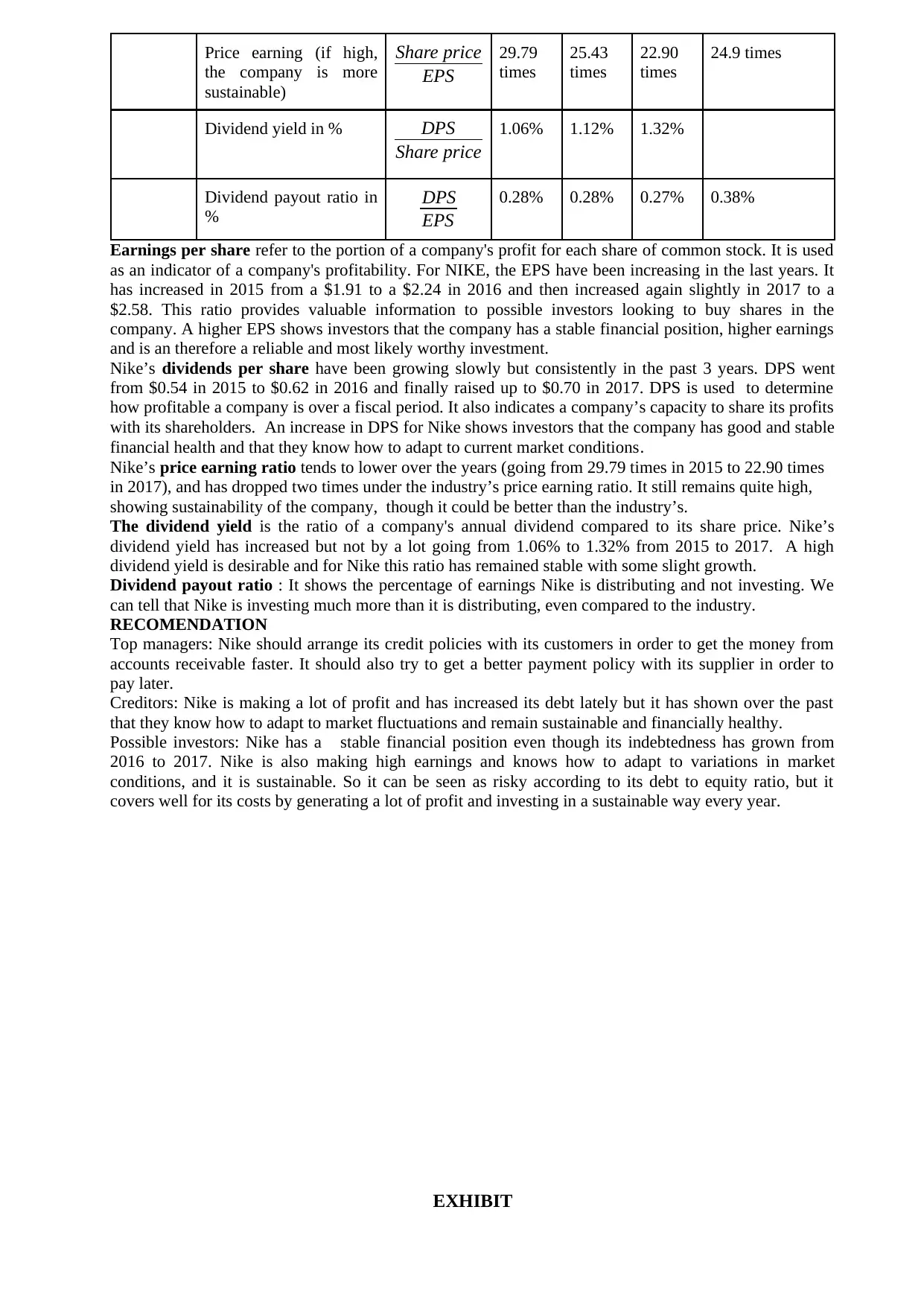
Price earning (if high,
the company is more
sustainable)
Share price
EPS
29.79
times
25.43
times
22.90
times
24.9 times
Dividend yield in % DPS
Share price
1.06% 1.12% 1.32%
Dividend payout ratio in
%
DPS
EPS
0.28% 0.28% 0.27% 0.38%
Earnings per share refer to the portion of a company's profit for each share of common stock. It is used
as an indicator of a company's profitability. For NIKE, the EPS have been increasing in the last years. It
has increased in 2015 from a $1.91 to a $2.24 in 2016 and then increased again slightly in 2017 to a
$2.58. This ratio provides valuable information to possible investors looking to buy shares in the
company. A higher EPS shows investors that the company has a stable financial position, higher earnings
and is an therefore a reliable and most likely worthy investment.
Nike’s dividends per share have been growing slowly but consistently in the past 3 years. DPS went
from $0.54 in 2015 to $0.62 in 2016 and finally raised up to $0.70 in 2017. DPS is used to determine
how profitable a company is over a fiscal period. It also indicates a company’s capacity to share its profits
with its shareholders. An increase in DPS for Nike shows investors that the company has good and stable
financial health and that they know how to adapt to current market conditions.
Nike’s price earning ratio tends to lower over the years (going from 29.79 times in 2015 to 22.90 times
in 2017), and has dropped two times under the industry’s price earning ratio. It still remains quite high,
showing sustainability of the company, though it could be better than the industry’s.
The dividend yield is the ratio of a company's annual dividend compared to its share price. Nike’s
dividend yield has increased but not by a lot going from 1.06% to 1.32% from 2015 to 2017. A high
dividend yield is desirable and for Nike this ratio has remained stable with some slight growth.
Dividend payout ratio : It shows the percentage of earnings Nike is distributing and not investing. We
can tell that Nike is investing much more than it is distributing, even compared to the industry.
RECOMENDATION
Top managers: Nike should arrange its credit policies with its customers in order to get the money from
accounts receivable faster. It should also try to get a better payment policy with its supplier in order to
pay later.
Creditors: Nike is making a lot of profit and has increased its debt lately but it has shown over the past
that they know how to adapt to market fluctuations and remain sustainable and financially healthy.
Possible investors: Nike has a stable financial position even though its indebtedness has grown from
2016 to 2017. Nike is also making high earnings and knows how to adapt to variations in market
conditions, and it is sustainable. So it can be seen as risky according to its debt to equity ratio, but it
covers well for its costs by generating a lot of profit and investing in a sustainable way every year.
EXHIBIT
the company is more
sustainable)
Share price
EPS
29.79
times
25.43
times
22.90
times
24.9 times
Dividend yield in % DPS
Share price
1.06% 1.12% 1.32%
Dividend payout ratio in
%
DPS
EPS
0.28% 0.28% 0.27% 0.38%
Earnings per share refer to the portion of a company's profit for each share of common stock. It is used
as an indicator of a company's profitability. For NIKE, the EPS have been increasing in the last years. It
has increased in 2015 from a $1.91 to a $2.24 in 2016 and then increased again slightly in 2017 to a
$2.58. This ratio provides valuable information to possible investors looking to buy shares in the
company. A higher EPS shows investors that the company has a stable financial position, higher earnings
and is an therefore a reliable and most likely worthy investment.
Nike’s dividends per share have been growing slowly but consistently in the past 3 years. DPS went
from $0.54 in 2015 to $0.62 in 2016 and finally raised up to $0.70 in 2017. DPS is used to determine
how profitable a company is over a fiscal period. It also indicates a company’s capacity to share its profits
with its shareholders. An increase in DPS for Nike shows investors that the company has good and stable
financial health and that they know how to adapt to current market conditions.
Nike’s price earning ratio tends to lower over the years (going from 29.79 times in 2015 to 22.90 times
in 2017), and has dropped two times under the industry’s price earning ratio. It still remains quite high,
showing sustainability of the company, though it could be better than the industry’s.
The dividend yield is the ratio of a company's annual dividend compared to its share price. Nike’s
dividend yield has increased but not by a lot going from 1.06% to 1.32% from 2015 to 2017. A high
dividend yield is desirable and for Nike this ratio has remained stable with some slight growth.
Dividend payout ratio : It shows the percentage of earnings Nike is distributing and not investing. We
can tell that Nike is investing much more than it is distributing, even compared to the industry.
RECOMENDATION
Top managers: Nike should arrange its credit policies with its customers in order to get the money from
accounts receivable faster. It should also try to get a better payment policy with its supplier in order to
pay later.
Creditors: Nike is making a lot of profit and has increased its debt lately but it has shown over the past
that they know how to adapt to market fluctuations and remain sustainable and financially healthy.
Possible investors: Nike has a stable financial position even though its indebtedness has grown from
2016 to 2017. Nike is also making high earnings and knows how to adapt to variations in market
conditions, and it is sustainable. So it can be seen as risky according to its debt to equity ratio, but it
covers well for its costs by generating a lot of profit and investing in a sustainable way every year.
EXHIBIT
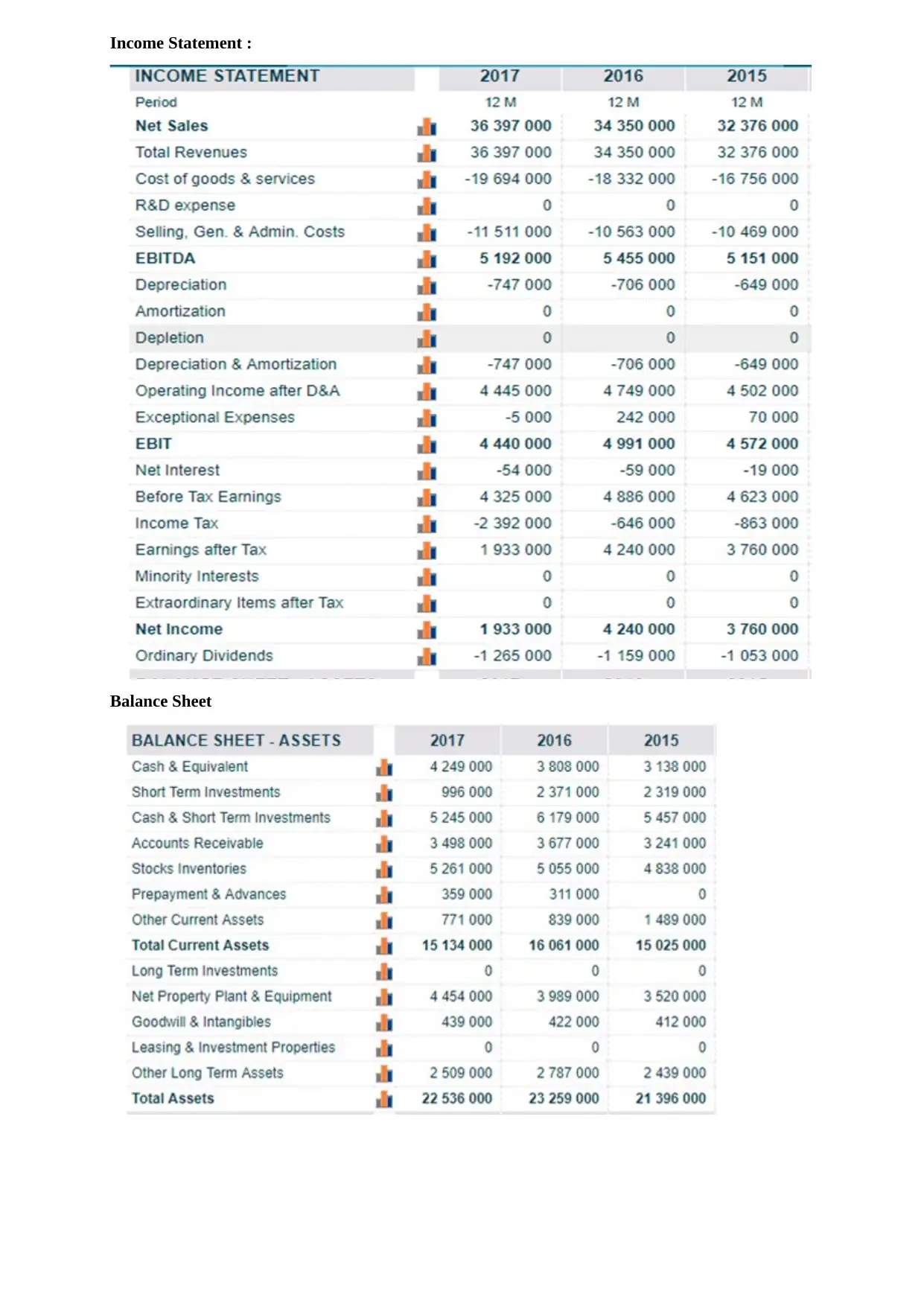
Income Statement :
Balance Sheet
Balance Sheet
⊘ This is a preview!⊘
Do you want full access?
Subscribe today to unlock all pages.

Trusted by 1+ million students worldwide
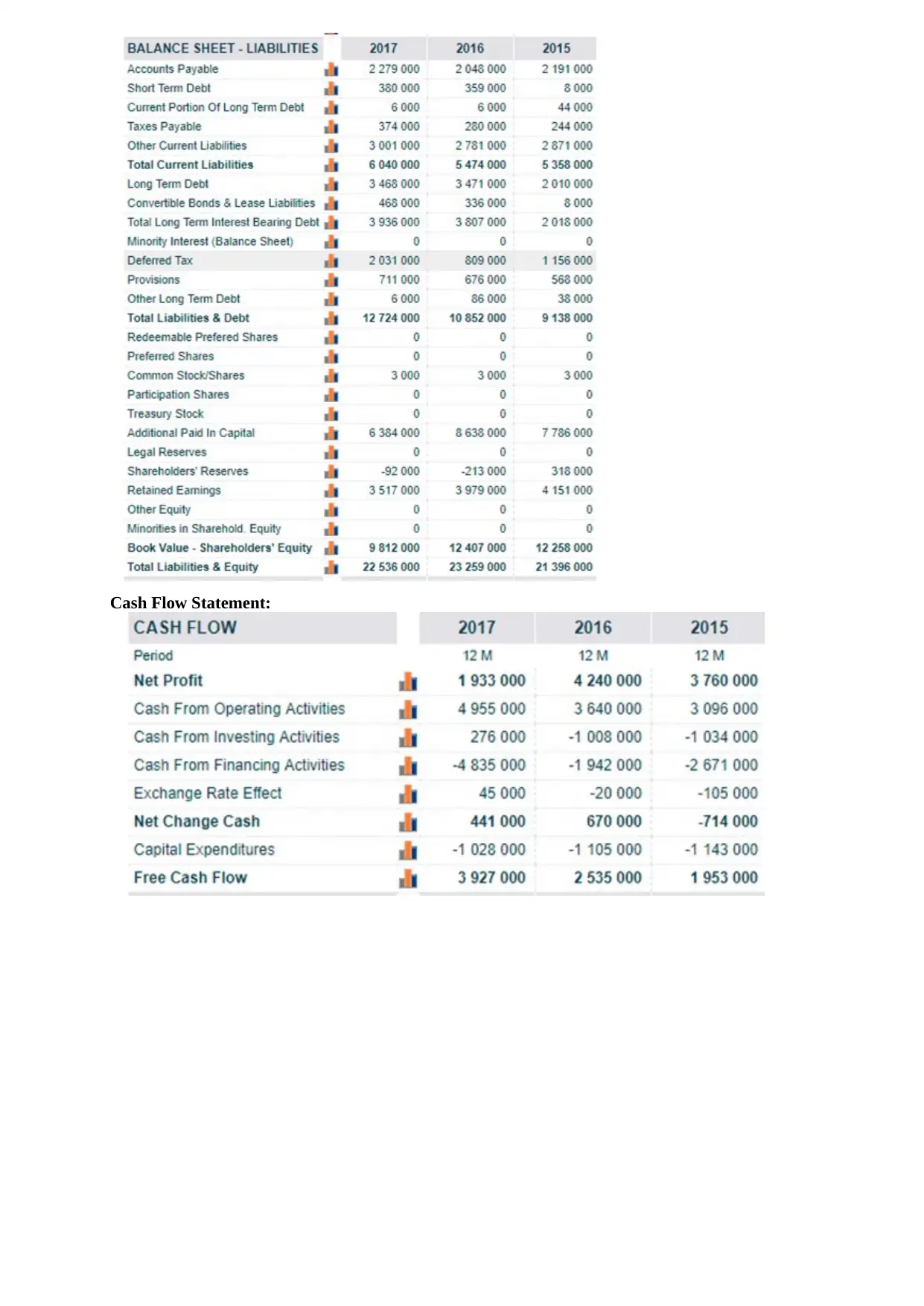
Cash Flow Statement:
Paraphrase This Document
Need a fresh take? Get an instant paraphrase of this document with our AI Paraphraser
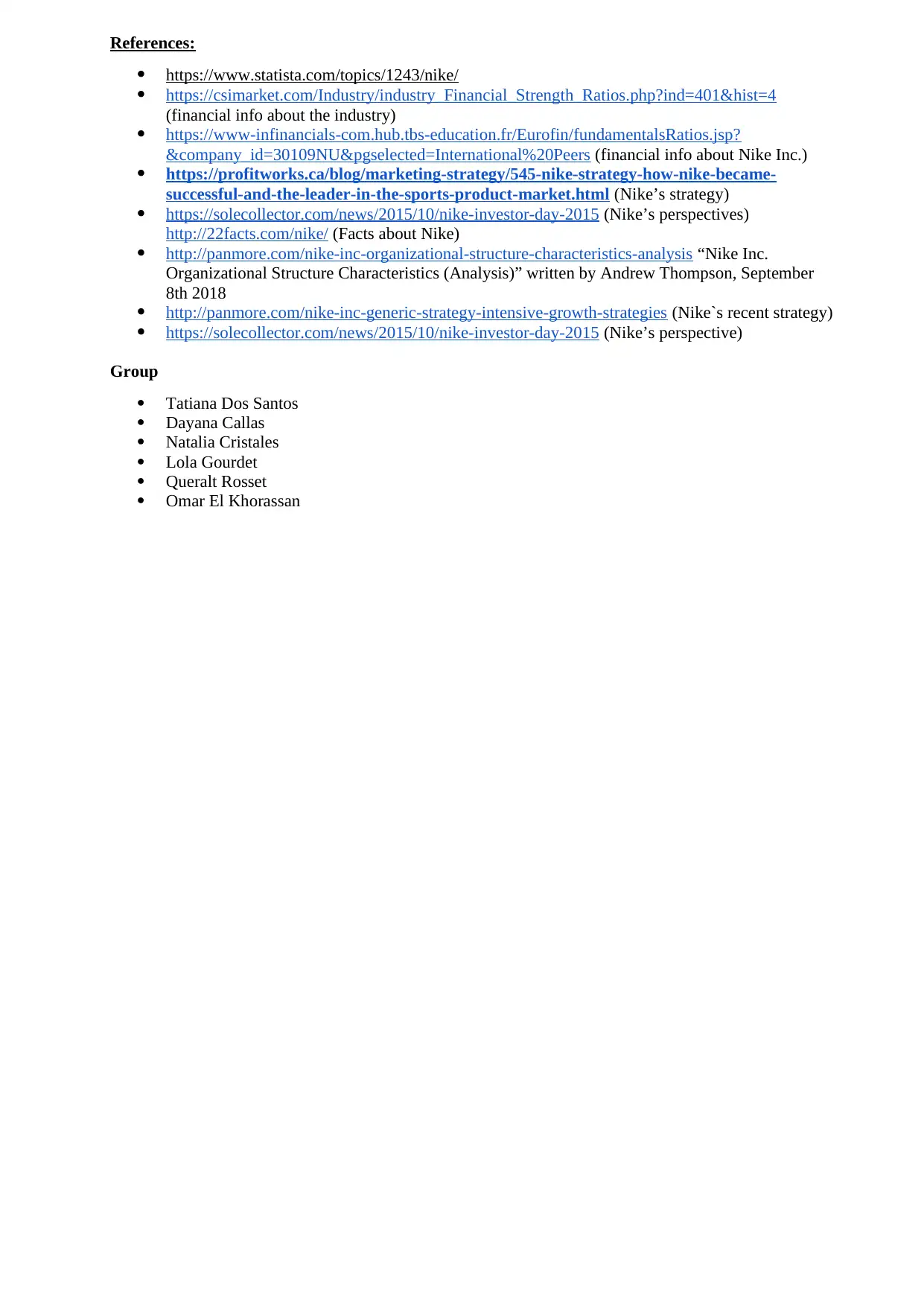
References:
https://www.statista.com/topics/1243/nike/
https://csimarket.com/Industry/industry_Financial_Strength_Ratios.php?ind=401&hist=4
(financial info about the industry)
https://www-infinancials-com.hub.tbs-education.fr/Eurofin/fundamentalsRatios.jsp?
&company_id=30109NU&pgselected=International%20Peers (financial info about Nike Inc.)
https://profitworks.ca/blog/marketing-strategy/545-nike-strategy-how-nike-became-
successful-and-the-leader-in-the-sports-product-market.html (Nike’s strategy)
https://solecollector.com/news/2015/10/nike-investor-day-2015 (Nike’s perspectives)
http://22facts.com/nike/ (Facts about Nike)
http://panmore.com/nike-inc-organizational-structure-characteristics-analysis “Nike Inc.
Organizational Structure Characteristics (Analysis)” written by Andrew Thompson, September
8th 2018
http://panmore.com/nike-inc-generic-strategy-intensive-growth-strategies (Nike`s recent strategy)
https://solecollector.com/news/2015/10/nike-investor-day-2015 (Nike’s perspective)
Group
Tatiana Dos Santos
Dayana Callas
Natalia Cristales
Lola Gourdet
Queralt Rosset
Omar El Khorassan
https://www.statista.com/topics/1243/nike/
https://csimarket.com/Industry/industry_Financial_Strength_Ratios.php?ind=401&hist=4
(financial info about the industry)
https://www-infinancials-com.hub.tbs-education.fr/Eurofin/fundamentalsRatios.jsp?
&company_id=30109NU&pgselected=International%20Peers (financial info about Nike Inc.)
https://profitworks.ca/blog/marketing-strategy/545-nike-strategy-how-nike-became-
successful-and-the-leader-in-the-sports-product-market.html (Nike’s strategy)
https://solecollector.com/news/2015/10/nike-investor-day-2015 (Nike’s perspectives)
http://22facts.com/nike/ (Facts about Nike)
http://panmore.com/nike-inc-organizational-structure-characteristics-analysis “Nike Inc.
Organizational Structure Characteristics (Analysis)” written by Andrew Thompson, September
8th 2018
http://panmore.com/nike-inc-generic-strategy-intensive-growth-strategies (Nike`s recent strategy)
https://solecollector.com/news/2015/10/nike-investor-day-2015 (Nike’s perspective)
Group
Tatiana Dos Santos
Dayana Callas
Natalia Cristales
Lola Gourdet
Queralt Rosset
Omar El Khorassan
1 out of 8
Related Documents
Your All-in-One AI-Powered Toolkit for Academic Success.
+13062052269
info@desklib.com
Available 24*7 on WhatsApp / Email
![[object Object]](/_next/static/media/star-bottom.7253800d.svg)
Unlock your academic potential
Copyright © 2020–2025 A2Z Services. All Rights Reserved. Developed and managed by ZUCOL.





